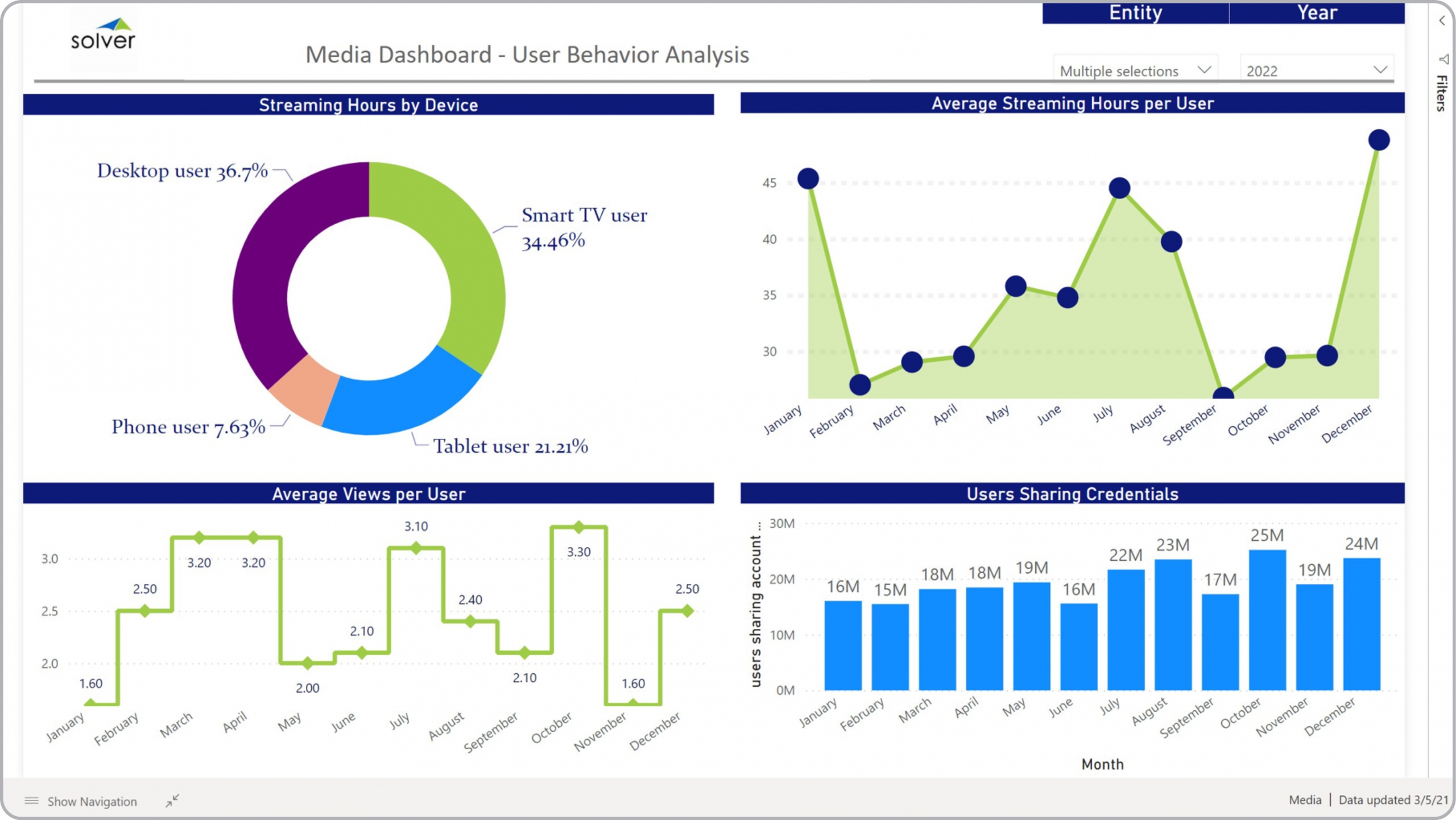User Behavior Dashboard for Media Companies
What is a
User Behavior Dashboard
? User Behavior Dashboards are considered operational analysis tools and are used by marketing and content managers to monitor key user metrics and trends. Some of the main functionality in this type of dashboard is that it enables graphical analysis of user behavior from four different perspectives, including: 1) Streaming hours by device (such as cell phone, desktop, smart TV, tablet), 2)Monthly trends in average views per user, 3) Monthly hours in average streaming hours per user, and 4) Monthly trend in user sharing credentials. You find an example of this type of dashboard below.
Purpose of
User Behavior Dashboard Media companies deploy User Behavior Dashboard to get a real time view of KPIs and trends related to their users. When used as part of good business practices in Product and Marketing departments, a company can improve its content and delivery strategies, and it can reduce the chances that decisions are slower than needed due to lack of clear data insights.
Example of a
User Behavior Dashboard Here is an example of a User Behavior Dashboard with KPIs and trends. [caption id="" align="alignnone" width="2560"]
 Example of a User Behavior Dashboard for Media Companies[/caption] You can find hundreds of additional examples
here
Who Uses This Type of
Dashboard
? The typical users of this type of dashboard are: Category managers, media managers, media analysts, sales managers, marketing managers.
Other Reports Often Used in Conjunction with
User Behavior Dashboard Progressive Product and Marketing departments sometimes use several different User Behavior Dashboard, along with detailed user behavior reports, subscriber and churn reports, sales forecasts, user forecasts, annual budgets and other management and control tools.
Where Does the Data for Analysis Originate From? The Actual (historical transactions) data typically comes from enterprise resource planning (ERP) systems like: Microsoft Dynamics 365 (D365) Finance, Microsoft Dynamics 365 Business Central (D365 BC), Microsoft Dynamics AX, Microsoft Dynamics NAV, Microsoft Dynamics GP, Microsoft Dynamics SL, Sage Intacct, Sage 100, Sage 300, Sage 500, Sage X3, SAP Business One, SAP ByDesign, Acumatica, Netsuite and others. In analyses where budgets or forecasts are used, the planning data most often originates from in-house Excel spreadsheet models or from professional corporate performance management (CPM/EPM) solutions.
What Tools are Typically used for Reporting, Planning and Dashboards? Examples of business software used with the data and ERPs mentioned above are:
Example of a User Behavior Dashboard for Media Companies[/caption] You can find hundreds of additional examples
here
Who Uses This Type of
Dashboard
? The typical users of this type of dashboard are: Category managers, media managers, media analysts, sales managers, marketing managers.
Other Reports Often Used in Conjunction with
User Behavior Dashboard Progressive Product and Marketing departments sometimes use several different User Behavior Dashboard, along with detailed user behavior reports, subscriber and churn reports, sales forecasts, user forecasts, annual budgets and other management and control tools.
Where Does the Data for Analysis Originate From? The Actual (historical transactions) data typically comes from enterprise resource planning (ERP) systems like: Microsoft Dynamics 365 (D365) Finance, Microsoft Dynamics 365 Business Central (D365 BC), Microsoft Dynamics AX, Microsoft Dynamics NAV, Microsoft Dynamics GP, Microsoft Dynamics SL, Sage Intacct, Sage 100, Sage 300, Sage 500, Sage X3, SAP Business One, SAP ByDesign, Acumatica, Netsuite and others. In analyses where budgets or forecasts are used, the planning data most often originates from in-house Excel spreadsheet models or from professional corporate performance management (CPM/EPM) solutions.
What Tools are Typically used for Reporting, Planning and Dashboards? Examples of business software used with the data and ERPs mentioned above are:
- Native ERP report writers and query tools
- Spreadsheets (for example Microsoft Excel)
- Corporate Performance Management (CPM) tools (for example Solver)
- Dashboards (for example Microsoft Power BI and Tableau)
Corporate Performance Management (CPM) Cloud Solutions and More Examples
May 29, 2021
TAGS:
Reporting,
Solver,
report writer,
Microsoft,
average views per user,
template,
practice,
Acumatica,
Netsuite,
TV,
streaming,
Finance,
device,
planning,
GP,
dashboard,
Business Central,
excel,
radio,
ax,
forecast,
Budget,
Dynamics 365,
budgeting,
Cloud,
Software,
Tableau,
streaming hours,
SAP,
example,
media,
best,
Sage,
BC,
D365,
NAV,
Intacct,
credential sharing,
broadcast,
online,
CPM,
report,
SL,
Management,
dynamics,
internet,
Power BI

